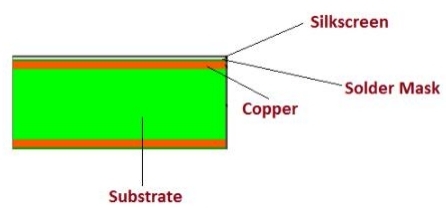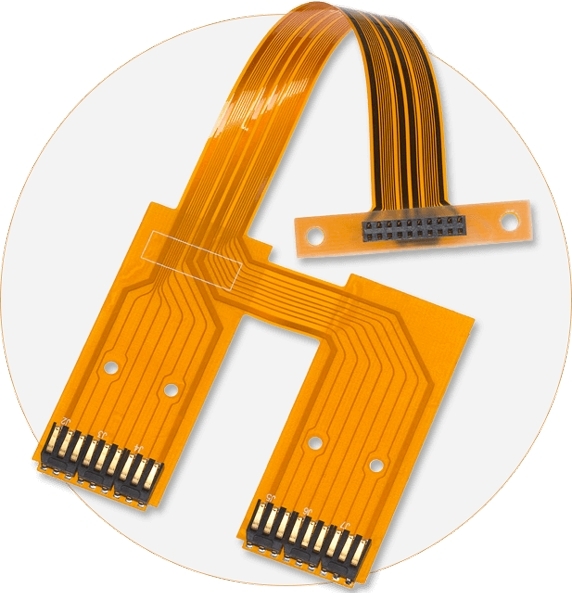The Ultimate Detailed Guide to Rigid Flex PCB
What is a rigid flex PCB?
A rigid flex PCB (Printed Circuit Board) makes the best of flexible and rigid-board technologies and can be used for multiple cases. Depending on different rigid flex designs, the rigid flex assembly may vary when rigid flex PCB could be combined with a wide range of materials to support different applications.
Rigid flex PCBs usually are made of multiple layers of flexible circuit substrates, they are attached to one or more rigid boards externally and/or internally, then completed in a constant state of flex, and usually formed into the flexed curve during manufacturing or installation.

Flex Vs. Rigid Flex Vs. Rigid PCBs: How Are They Different?
Rigid PCBs generally use FR4 board (glass fiber copper clad laminate) as the base material, featuring solid and unbending boards, for the trait of being unbendable, PCBs of this sort are called “Rigid PCBs”.


Flex PCBs have a flexible base. Due to their ability to endure vibration, fold or bend into different shapes, and disperse heat, flexible PCBs are becoming more and more popular in today’s electronics. Besides, some flex printed circuit boards can be divided into single-layer flex PCB,double-layer flex PCB,and multilayer flex PCB by their layer construction as the number of layers can be 2, 4, and up to 6.

What makes flexible and rigid PCBs different from each other lies in the types they support. Flexible PCBs are more pliable, while rigid ones are more durable. Besides, while flexible PCBs can withstand a range of temperatures, Rigid PCBs can be applied in more extreme temperature scenarios, Both types are ideal for high-end products, but flexible ones are usually lighter with more adjustable FPC while rigid ones are heavier. Furthermore, the FPC(Flexible Printed Circuit) of flexible PCBs can accept more severe tolerances than FFCs, which makes flexible PCBs a better choice for many tech applications.
Rigid Flex PCBs are a combination of both rigid and flex components, rigid flex PCB manufacturers make the most of the advantages of both rigid PCB and flex PCBs, crafting from flexible and rigid layers of circuit substrates and circuit board materials.
Types of rigid flex PCBs
They fall into two groups. (Depending on the process of joining the rigid and the flex PCBs.)
- Rigid flexible Composite PCB –The rigid and flexible circuit boards are combined during production. A common blind & buried viadesign will be noticed between the two boards. This type will have a higher-density circuit design. Blind vias are those that connect two layers but do not penetrate the outer layers. Buried vias are useful for trace routingand augment circuit space by allowing different component pads to connect. Rigid flex PCBs should be designed with as few vias as possible and to avoid via placement.
- Rigid flexible PCB – The rigid and flexible circuit boards are produced separately and then get laminated together. The through-hole design doesn’t apply here.
Rigid flex PCB Technology and Production Process
It’s more complex to produce a rigid flex PCB, requiring more materials and manpower. However, rigid flex PCBs are performing well in high-performance applications like TVs and medical devices, so they are definitely worth the extra money. These circuit boards are also widely used in low-tech, bendable applications, such as kitchen cabinets and LED lighting. These bendable PCBs have flexibility allowing them to fit tightly into small spaces and reduce layout flaws.
Whether constructing a rigid flex PCB prototype or production quantities needing large-scale PCB fabrication and PCB assembly, the technology is well-proven and reliable. Especially good in solving space and weight issues, the FLEX PCB portion is made with spatial degrees of freedom.
Attentive consideration for rigid flex PCB solutions and a thorough check of the available options at the start of the rigid flex design phase will yield significant benefits. It's so necessary for the PCB fabricator to be involved in the early design process to guarantee both the design and fab portions are coordinating well, and to be responsible for the final product variations.
Advantages of Rigid Flex PCBs
Rigid Flex PCB shows advantages over traditional PCBs in several areas, including making installation and packaging much easier. It is also very cost-effective, and more of a good choice for high-density applications. Rigid Flex PCBs have a range of advantages, making them stand out as ideal choices for many applications. An excellent example of merits rigid flex PCB can bring about is for 3D printers, as they boast a flexible tape that allows them to move back and forth without any restrictions. The Flex PCB is one of the essential parts of a printer, as the machine can't print without it.
As rigid flex PCB boards are designed in a 3D space, which also enables greater spatial efficiency. By Designing them in three dimensions, the flexible board substrates can be twisted, folded, and rolled to achieve the desired shape as the designers want for diverse applications.
Compared to normal Printed circuit boards, a rigid flex PCB has multiple different layers of both rigid and flexible technology so that it may function at a superb level without worrying that it may break. Rigid Flex PCB manufacturers make rigid flex PCB bendable, non-fragile, and also in a steady state of a curve, which means if you stretch or compress it, it will return to its original state.
By combining the properties of rigid and flexible PCBs, rigid flex PCBs come with a host of benefits for both manufacturers and consumers.
See more benefits of Rigid Flex PCB here:
- Mechanical stability- Their basic structure consists of interchanging layers of rigid and flexible PCBs. This ensures that they're both stable and flexible, facilitating easy installation in small spaces.It is also possible to increase the complexity of mechanical designs, which also improves the degree of freedom for optimized housing solutions.
- Connection reliability- With rigid flex PCBs, you get greater stability and polarity, making connections easier and more secure with other components.By removing the need for connectors and cables between the individual rigid parts, the board size and overall system weight can be reduced.
- Simplified PCB assembly processes- By maximizing space, there is often a lower count of parts needed for a rigid flex PCB assembly You will also require fewer connector components with each application. Also, Integrated ZIF contacts provide simple modular interfaces to the system environment.
- SimplifiedTest conditions - A complete test before installation becomes possible.
- Dynamism- Along with repeatability and precision, you'll enjoy greater flexibility with packaging.
- Cost-effective- By using rigid flex PCBs, you can cut down ontotal expenditures. Rigid Flex assembly and logistical costs are lower.
- High-density applications- Arguably, the best benefit of rigid flexPCBs is that they can be used for a high-density device population. This is due to their flexibility, stability, and low space use.
- High shock and vibration resistance- Electronic components are used in a wide range of items, some of which experience constant vibrations. With such devices, you won't have to worry about damage as rigid flex PCB is highly resistant to shock and vibration.
- Minimized Space requirements-Space requirements can be reduced by applying 3D.
Applications for rigid flex PCBs & Circuits
There is a wide range of areas where rigid flex printed circuit boards can be applied in, from smart devices to cell phones and digital cameras. For their space and weight reduction capabilities, rigid flex board fabrication has been used in medical devices such as pacemakers. Relying on the same merits, rigid flex PCB usage can be applied to smart control systems.
In consumer products, rigid flex PCBs minimize space and weight as well as greatly improves reliability, eliminating many needs for solder joints and delicate, fragile wirings that may give rise to connection issues.
More than that, rigid flex PCBs can be used to benefit nearly all advanced electrical applications including testing equipment, tools, and automobiles.
What makes rigid flex circuits stand out are their reliability, compact size, and low weight. In addition, you can build them to precisely fit the device they fit into. Manufacturers are under pressure to fit higher-end technology into smaller spaces, so rigid flex circuits are a great choice. They allow for a denser device population with lighter conductors while maintaining a high level of flexibility.
There are several other benefits of rigid flex circuits. These include lower costs for rigid flex PCB manufacturers and better connection reliability, polarity, and flexibility in packaging. Moreover, rigid flex circuits are highly reliable and can easily integrate into various applications. They cost less than traditional circuit boards and can be useful in high-density applications.
Furthermore, you can manufacture these rigid flex circuits in various sizes and densities. For example, polyimide circuit boards can have a high density of connection points, enabling high-density circuit routing. Rigid Flex circuits also minimize the overall weight of a system. As a result, they are ideal for high-shock and vibration applications.
Other Rigid Flex PCB applications include:
- Medical wearables – to identify and track breathing patterns and heart rates, applied in CT scans & pacemakers as well.
- Industrial applications – Like power distribution circuits and RFdevices
- eCommerce – For scanning and tracking shipment.(barcode scanners, cell phones, etc included)
Rigid Flex Design and Fabrication Issues
During the rigid flex design process, certain considerations must be taken into account for final product size variations. In the production of rigid flex boards, the flexible polyimide core will shrink once the bonded copper foil is etched away. This variation must be considered in the rigid flex design process.
The final rigid flex assembly process requires the flex portions to be bent into shape, stressing the flex laminations with the potential to cause stress fractures.
Elecrow: A Trustful Rigid Flex PCB manufacturer
As much as it is essential to choose the suitable PCB material, the significance of selecting the proper PCB manufacturer couldn't be denied. Elecrow PCB has proven to be one of the best China PCB assembly manufacturers offering the finest Rigid Flex PCBs.
The best part is that you will have your choice of PCB manufactured, keeping the application of your PCB in line. We always consider the requirements of our clients, and after a thorough discussion and assessment of the PCB application, we develop Rigid Flex PCBs for them.
We focus on quality, appropriate bonding within the PCB structure, and cost-effectiveness. Hence this allows us to provide our clients with a perfect PCB choice that lasts longer and help them reduce the assembly cost as well as minimize space requirements.
